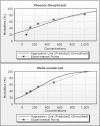Evaluation of Some Plant Fruit Extracts for the Control of West Nile Virus Vector Culex pipiens (Diptera: Culicidae)
- PMID: 28032112
- PMCID: PMC5186750
Evaluation of Some Plant Fruit Extracts for the Control of West Nile Virus Vector Culex pipiens (Diptera: Culicidae)
Abstract
Background: The extracts of different parts of plants were found very effective against various pests. The aim of this research was to determine the insecticidal activity of fruit methanol extracts obtained from Melia azedarach (Meliaceae), Phoenix theophrasti (Arecaceae), Styphnolobium japonicum (Fabaceae) and Pyracantha coccinea (Rosaceae) against the larvae of Culex pipiens (Diptera: Culicidae).
Methods: The fruits of test plants were collected from the Campus of Akdeniz University, Antalya, Turkey in 2013. A series of concentrations of the extracts ranging from 62.5-1000 ppm were tested against second instar larvae.
Results: Only the extracts of Me. azedarach and Ph. theoprasti showed significant larvicidal activity against Cx. pipiens and the LC50 values of these extracts were found to be 169.48 and 220.60 ppm, respectively. This is the first research investigating the insecticidal or larvicidal activity of Ph. theophrasti, St. japonicum and Py. coccinea extracts on mosquitoes.
Conclusion: The methanol extract of fruits of Me. azedarach and Ph. theophrasti showed significantly higher larvicidal activity against Cx. pipiens.
Keywords: Larvicidal; Melia azedarach; Phoenix theophrasti; Pyracantha coccinea; Styphnolobium japonicum.
Figures
Similar articles
-
Evaluating larvicidal, ovicidal and growth inhibiting activity of five medicinal plant extracts on Culex pipiens (Diptera: Culicidae), the West Nile virus vector.Sci Rep. 2024 Aug 23;14(1):19660. doi: 10.1038/s41598-024-69449-6. Sci Rep. 2024. PMID: 39191818 Free PMC article.
-
Phytochemical composition of almond oil from Melia azedarach L. and its larvicidal, ovicidal, repellent and enzyme activities in Culex pipiens L.Trop Biomed. 2022 Dec 1;39(4):531-538. doi: 10.47665/tb.39.4.008. Trop Biomed. 2022. PMID: 36602212
-
Larvicidal and adulticidal activity of essential oils from plants of the Lamiaceae family against the West Nile virus vector, Culex pipiens (Diptera: Culicidae).Saudi J Biol Sci. 2022 Aug;29(8):103350. doi: 10.1016/j.sjbs.2022.103350. Epub 2022 Jun 16. Saudi J Biol Sci. 2022. PMID: 35762012 Free PMC article.
-
Larvicidal Activity of Nerium oleander against Larvae West Nile Vector Mosquito Culex pipiens (Diptera: Culicidae).J Parasitol Res. 2015;2015:943060. doi: 10.1155/2015/943060. Epub 2015 Nov 11. J Parasitol Res. 2015. PMID: 26640701 Free PMC article.
-
Larvicidal activity of Cyclamen (Myrsinaceae) extracts against the larvae of West Nile virus vector Culex pipiens L. (Diptera: Culicidae).Asian Pac J Trop Med. 2013 Jun;6(6):449-52. doi: 10.1016/S1995-7645(13)60072-3. Asian Pac J Trop Med. 2013. PMID: 23711704
References
-
- Becker N. (2008) Influence of climate change on mosquito development and mosquito-borne diseases in Europe. Parasitol Res. 103(1): S19–S28. - PubMed
-
- Cecilia KF, Ravindhran R, Gandhi MR, Reegan AD, Balakrishna K, Ignacimuthu S. (2014) Larvicidal and pupicidal activities of ecbolin A and ecbolin B isolated from Ecbolium viride (Forssk.) Alston against Culex quinquefasciatus Say (Diptera: Culicidae). Parasitol Res. 113(9): 3477–3484. - PubMed
-
- Cetin H, Dechant P, Yanikoglu A. (2007) Field trials with tank mixtures of Bacillus thuringiensis subsp israelensis and Bacillus sphaericus formulations against Culex pipiens larvae in septic tanks in Antalya, Turkey. J Am Mosq Control Assoc. 23: 161–165. - PubMed
-
- Cetin H, Yanikoglu A, Cilek JE. (2005) Evaluation of the naturally-derived insecticide spinosad against Culex pipiens L. (Diptera: Culicidae) larvae in septic tank water in Antalya, Turkey. J Vector Ecol. 30: 151–154. - PubMed
-
- Cetin H, Yanikoglu A, Cilek JE. (2006) Efficacy of diflubenzuron, a chitin synthesis inhibitor, against Culex pipiens larvae in septic tank water. J Am Mosq Control Assoc. 22: 343–345. - PubMed
LinkOut - more resources
Full Text Sources

